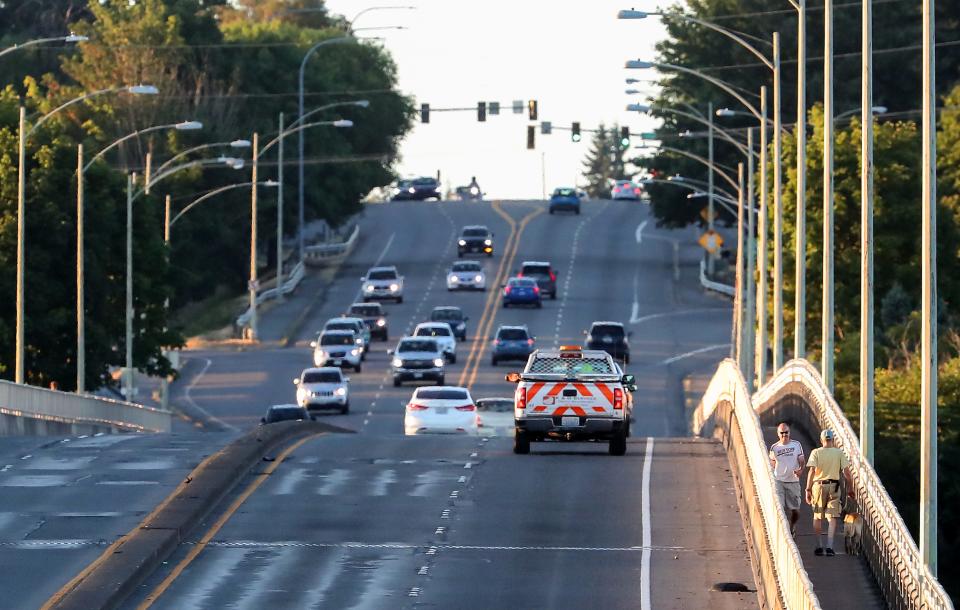Sidewalks for Warren Avenue Bridge redesign likely smaller than planned, due to budget
After receiving a warning about a potential loss of some state transportation funding, the Bremerton City Council is preparing to alter course on a preferred design to extend the sidewalks on either side of the Warren Avenue Bridge. Forced to abandon their previous custom alternative of new sidewalks the width of 12 feet and 8 feet, the council will now vote on a new design with a smaller sidewalk on one side of the bridge at its April 17 meeting.
The City Council voted 4-2 in August to adopt a plan known as 'Alternative X,' championed by Councilman Jeff Coughlin. That plan called for designs of a 12-foot sidewalk on the west side of the bridge and an 8-foot sidewalk on the opposite side. The council selected the alternative, which Coughlin viewed as a compromise, rather than the three original proposed alternatives for redesigned pedestrian pathway on the bridge.
But at a study session on Wednesday, the council was faced with a decision to make another compromise, after Public Works and Utilities Director Tom Knuckey said that Alternative X would no longer fit the project’s estimated $26.5 million budget. He brought two alternatives – known as Alternatives 1 and 7 – back to the table.

Alternative 1 would have 8-foot sidewalks on both sides, while Alternative 7 would keep a 12-foot sidewalk on the east side, but decrease the width on the opposite side from eight feet to five. Both would fit into a smaller budget, Knuckey said.
Knuckey told the council in a letter on March 26 that $500,000 of the original $27 million authorized by the state Legislature for the project is now unsecured in the shadow of efforts to repeal the state's Climate Commitment Act through Initiative 2117, which will appear before voters in November.
He warned that securing additional grants wasn’t guaranteed and that those funds would pull from the same pots needed to finance projects like the Naval Avenue and 6th Street rechannelization project. Taking out a loan would invite substantial interest costs and the city doesn’t have enough money from the general or street fund to spare, Knuckey wrote in the letter. If the city was to stay on course with an alternative that exceeded grant funding, it would lose the design and its investment.
Council members were split unevenly at first, debating whether or not to nix Alternative 1, with a design for 8-foot sidewalks on both sides, after extensive public comment in the past revealed the community’s strong preference for at least one 12-foot sidewalk.
City Council President Jennifer Chamberlin and councilmember Anna Mockler posited removing Alternative 1, aligning with public interest in a walkway with enough space for wheelchairs, commuting cyclists and pedestrians to comfortably maneuver the bridge and each other.
“There is a lot of knowledge and expertise that is very focused on multimodal life – it's a lifestyle – and those people came to us individually and collectively,” councilmember Denise Frey said in agreement. ”I am going to listen to an advocacy group.”
With a similar interest in safety, councilmember Michael Goodnow fought to keep Alternative 1 on the table, saying “I support 12- foot. I really don't support 5-foot, and if we all are saying that 12 is ideal, how do we accept five feet? I know there are avid cyclists, but there are also people who are just ‘schlunking’ on a bike and they're not probably going to cross over (to the narrower 5-foot side) and that's my concern.”
When asked, WSDOT regional administrator Steve Roark said WSDOT’s “desired shared-use path standard in 12 feet, 10-foot minimum, 5 (feet) meets ADA requirements, but we look forward to supporting whatever the community really wants.”
Councilmember Eric Younger initially sided with Goodnow on Alternative 1, unconvinced that Alternative 7 would be as safe. But later Younger put his decision on the sidewalk improvement in perspective of the Warren Avenue Bridge’s current three and a half-foot sidewalks.
“In the end, I think we should be grateful for any of these alternatives because it's a drastic improvement for what we have,” Younger said. “So, if I look at it like, ‘Hey, we're going to improve this bridge, we're going to have 12-foot all the way on one side, and the other side, which is 3 feet, is going to be increased to 5,’ I can sign off on that too because that's better than what we got.”
Coming to a consensus, the City Council drafted a resolution to adopt Alternative 7 for design on a 12-foot sidewalk and a 5-foot sidewalk. The proposal will accept comments from the public during the next meeting, at 5 p.m. on Wednesday at the city council chambers in the Norm Dicks Government Center, before a council vote to approve. If there are extra or additional funds, the resolution will divert those funds to financing connectors.
Editor's note: This story has been corrected. In the current proposed design, the 12-foot-wide sidewalk would be on the bridge's east side.
This article originally appeared on Kitsap Sun: Warren Avenue Bridge sidewalk design revised due to budget concern

